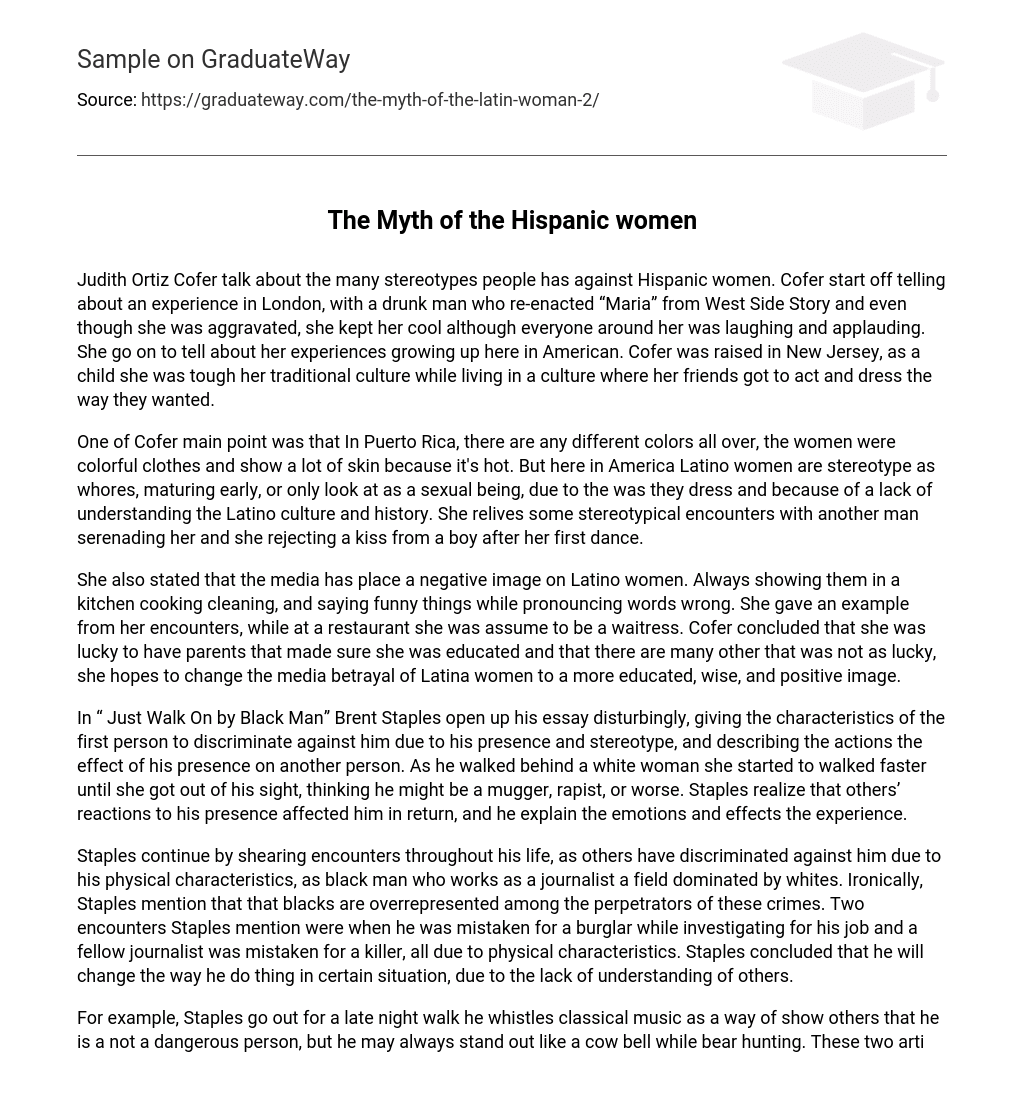Judith Ortiz Cofer discusses the numerous stereotypes that exist against Hispanic women. She begins by recounting an incident in London, where a drunk man impersonated “Maria” from West Side Story. Despite feeling irritated, Cofer remained composed, even as everyone around her laughed and applauded. She proceeds to share her personal experiences of growing up in America. Cofer was raised in New Jersey and as a child, she was taught her traditional culture, while also living in a society where her friends were free to express themselves through their behavior and attire.
Cofer’s main argument is that Puerto Rico is a place filled with vibrant colors, as seen in the diverse range of hues found everywhere. The women there dress in colorful attire and show more skin due to the warm climate. However, Cofer points out that in America, Latina women are often unfairly labeled as promiscuous or solely objectified for their dressing choices, prematurely perceived as sexually mature. This stereotype arises from a lack of comprehension about Latino culture and its historical context. Cofer recalls personal experiences where she encountered such stereotypes, including an incident where a man serenaded her and another when she declined a kiss after her first dance.
According to the speaker, the media has portrayed Latino women negatively by constantly depicting them in traditional gender roles such as cooking and cleaning, and making fun of their pronunciation. She shared a personal experience of being mistaken for a waitress at a restaurant as an illustration of this stereotype. However, the speaker expressed gratitude for her parents’ emphasis on education, acknowledging that not all Latina women have the same opportunities. She expressed a desire to challenge and transform the media’s perception of Latina women into one that is educated, wise, and positive.
In his essay “Just Walk On By: A Black Man,” Brent Staples begins by describing the characteristics of the first person who discriminated against him based on his presence and stereotype. He recounts how a white woman, upon noticing him walking behind her, started to walk faster until she was out of his sight, assuming he might be a mugger, rapist, or something worse. Staples realizes that others’ reactions to his presence also impact him, and he goes on to explain the emotions and effects of this experience.
Among Staples’ life experiences, he has faced ongoing discrimination due to his physical appearance as a black man in a predominantly white field, working as a journalist. Interestingly, Staples notes that black individuals are actually overrepresented as the perpetrators in these discriminatory situations. He recounts two specific incidents where he was falsely accused of being a burglar during his investigative work, and a fellow journalist was mistaken for a murderer solely based on their physical characteristics. These encounters have led Staples to reflect on the need to adapt his behavior in certain situations, given the lack of understanding from others.
For instance, Staples takes a late night stroll and uses classical music as a means to demonstrate that he is not a threat to others. However, this action may draw attention to him, much like a cow bell during a bear hunt. Both articles share similarities as both writers encounter discrimination based on stereotypes, prejudices, and a lack of understanding from others. They also face cultural conflicts; Cofer grows up in America while maintaining her own culture, and Staples rises from a ghetto upbringing to achieving higher education and climbing the social ladder.
The distinction lies in the discrimination faced by Cofer and other Latino women, who were sexually discriminated against and misrepresented by the media as maids. On the other hand, Staples and other black men faced discrimination from law enforcement and were wrongly portrayed as muggers and rapists. Both of these articles align with the themes discussed in the recent chapters we studied in class. Chapter 9 highlights the primary stereotype for Latino women, which states that they are only suitable for domestic work such as waiting tables at restaurants and cleaning homes – topics that Cofer writes about.
In Chapter 8, the text explores the experiences of African Americans and how prejudice and stereotypes result in discrimination. One specific illustration of this is the higher probability of law enforcement targeting young black males based on their skin color. This also plays a role in the unequal rates of incarceration for black individuals compared to other races, something Staples can personally identify with. These readings provide an alternative viewpoint on the obstacles encountered by racial minorities, deepening my comprehension of different forms of discrimination and prompting me to reserve judgment until I grasp others’ diversities.
These authors expand the perspective from their own personal experiences to address broader concerns and issues facing specific racial/ethnic groups. They assert that many individuals go through similar or even worse situations and have stories that parallel their own. By providing explanations and reasons to those who may not understand these individuals, they create an opportunity for understanding and potential for change. Having read both articles, I agree with and comprehend the viewpoints of both authors. I feel a connection with both of them because they both confront stereotypes, although Staples’ experiences resonate with me the most.
As a black man myself, I can personally relate to everything Staples discussed in his writing. Similar to Staples, I also grew up in a ghetto environment, known as the “good boy” who witnessed numerous tough individuals being incarcerated or even losing their lives. Although my parents were fortunate enough to move us to a better neighborhood, I still find myself unconsciously becoming a timid presence in certain situations. However, my experiences have made me resilient and a survivor. For instance, when I enter classrooms at Clayton State University, I often come across students who possess the same characteristics as the woman described by Staples in his opening paragraph.





